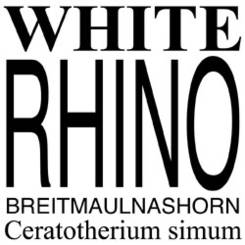Black Rhinoceros
Diceros bicornis
Swartrenoster (Afrikaans)
Tshukudu (Transvaal Sotho)
The Black Rhino has a shoulder height of 1,6 m and a mass of 900 - 1000 kg. The gestation is 15 - 16 months, single calf. It reaches a maximum speed of 45 km/h.
The hook-lipped, or black rhinoceros, has a distinctive prehensile lip. It holds its head high and is smaller then the square-lipped or white rhinoceros. The alternate name, black rhinoceros, alludes to being darker in colour than the white rhinoceros. An agile animal, the hook-lipped rhinoceros can display considerable aggression when alarmed. It is normally shy and usually solitary. Its eyesight is poor but it possesses exceptional hearing and good sense of smell. The head is held horizontal. In a charge - the whole portion of the body lifts off the ground when it tosses its target. The tail is held erect on the run. The black rhinoceros has a wide vocal range and, I believe, can communicate at a level inaudible to human hearing. Breathing is also an important part of communication. A sharp, strong snort followed by a fluttering sound, is an alarm or warning sound; a horse sound is used to make contact with other rhinoceros. It also makes loud puffing and snorting sounds.
The calf runs in behind the mother.
The black rhinos are browsers, also known to graze occasionally. Usual found in thickets where they eat shrubs, twigs and leaves. Thorns present no problem.
Usually defecates in middens or along various routes; dung is scattered with the hind legs. Easily identified by its fibrous and woody nature. Different colour to the dung of the white rhinoceros.
The spoor is much more compact and smaller than of the square-lipped rhinoceros. Urinates backwards against vegetation and then kicks back, often breaking up the vegetation. This action is a form of making territory and communication.
| |
White Rhinoceros
Ceratotherium simum
Witrenoster (Afrikaans)
Tshukudu, Mogohu (Transvaal Sotho)
The White Rhino has a shoulder height of 1,8 m and a mass of up to 2000 kg. The gestation is 18 months, single calf at intervals of 3 years.
The jaw is square and the head is carried low. Larger then the black rhinoceros, it is by contrast far more placid and less prone to attack. Curious by nature, tapping sounds draw its attention. In the event of a fast approach, get behind a tree. Eyesight is poor, but both hearing and smell acute. The trail loops over the back when the animal is on the move. It can reach speeds of up to 40 km/h over short distances. It is fond mud wallows and rubbing posts, which are often polished to a fine surface. The calf walks in front of the mother.
White rhinos are grass eaters.
They deposit their dung in large middens. Droppings are large and darkish-green when fresh, turning black with age. Resembles elephant dung in composition. Territorial bulls urinate backwards in a fine controlled spray. Trees and bushes are marked using the horn.
The spoor is three-toed; the forefoot is 28 cm long and 24 cm wide. Well-used trails often formed. They are experts at negotiating steep slopes. Spoor is longer that of the hook-lipped rhinoceros.
From 'SIGNS of the WILD' by Clive Walker
|


